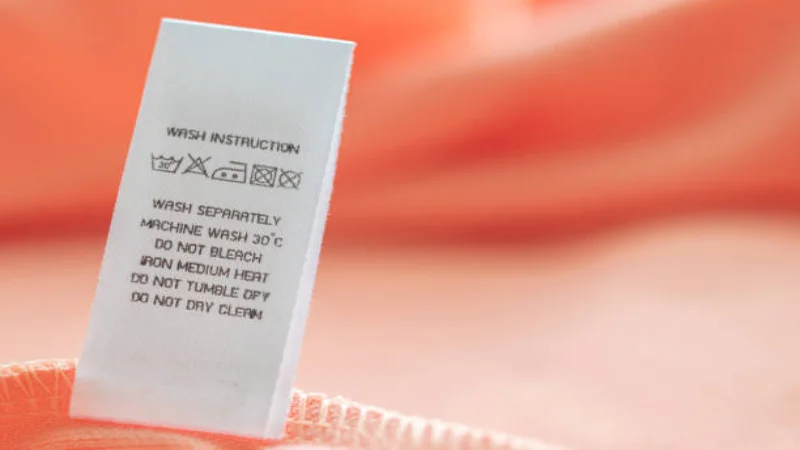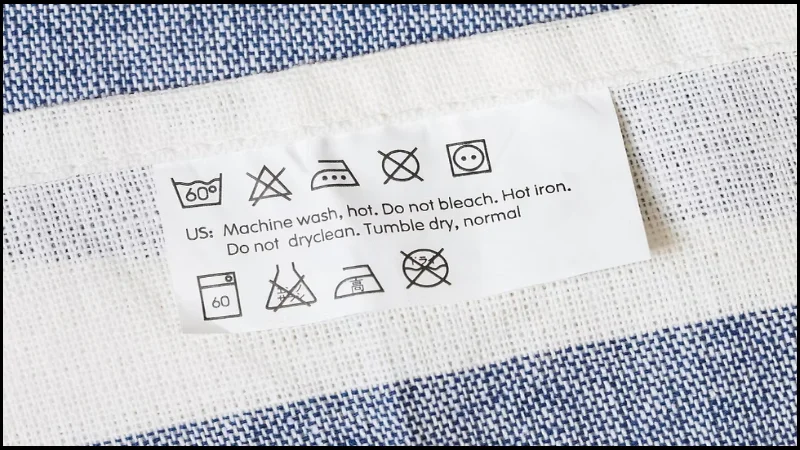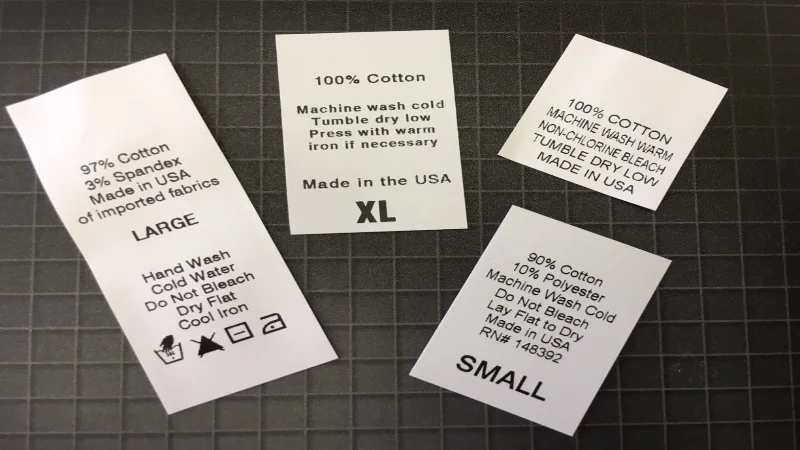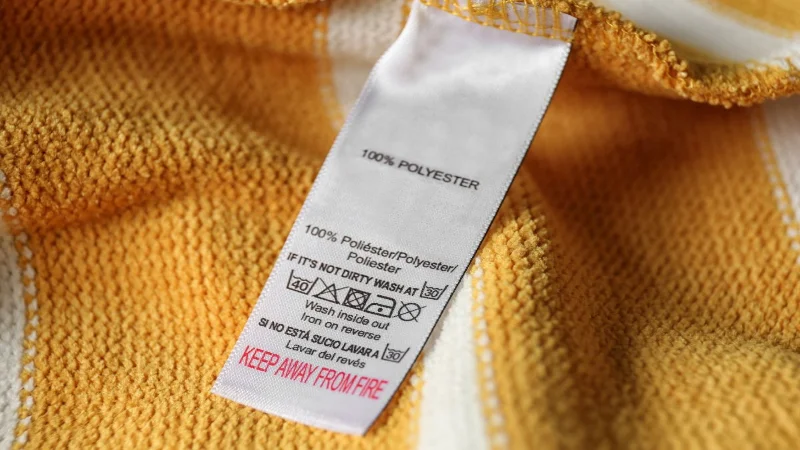Polyester Care Labels: Ultimate Guide to Washing and Preserving Fabrics
Polyester clothing is popular for its durability, but improper care can lead to damage, fading, and a shortened lifespan. This guide provides clear, practical steps for washing, drying, and caring for polyester, helping you extend the life of your garments, save money, and minimize environmental impact. You’ll understand care labels, treat stains, and ensure long-lasting quality.
1. Understanding Polyester: The Foundation of Fabric Care
Polyester is a versatile synthetic textile widely used in clothing. Known for its durability, wrinkle resistance and colorfastness, this washable fabric offers a blend of practicality and style from everyday wear to performance apparel.
Polyester boasts several key fabric properties. It’s quick-drying, resists shrinking and stretching and holds its shape well. Its inherent colorfastness means it resists fading, keeping your garments looking vibrant longer. This inherent versatility makes polyester a suitable fabric type for various applications.

2. Decoding the Care Label: Your Guide to Polyester’s Longevity
The care instructions on the clothing label are your primary resource for maintaining your polyester garments. Always consult this label before washing, drying or ironing. It’s a personalized guide from the manufacturer, providing the best methods to preserve your specific item. Don’t ignore the information there.
Care labels use a standardized set of laundry symbols to communicate instructions for washing, drying, ironing and bleaching. Familiarizing yourself with these symbols is essential for proper garment care. These symbols provide a quick, visual way to understand the recommended care procedures.
3. Washing Polyester: A Step-by-Step Guide
Washing instructions are crucial for maintaining polyester’s quality. Cold water is key. Wash polyester garments in cold water to preserve the fabric’s color and shape. Cold water helps prevent dye bleeding, reduces the risk of shrinkage and is more energy-efficient.
Use a mild laundry detergent specifically formulated for delicate fabrics. Avoid harsh detergents and those containing bleach or fabric softeners. These can damage the polyester fibers, leading to discoloration, weakening or a buildup of residue.
Sort polyester garments by color before washing. Wash light colors separately from dark colors to prevent any potential color bleeding or transfer during the wash cycle. Wash polyester items separately from fabrics that produce lint, such as towels or cotton sweaters. This will prevent lint from clinging to the polyester. Wash heavily soiled items separately.
When machine washing, always use a gentle cycle. Do not overload the machine; a good rule of thumb is to fill it to no more than 50% capacity. This allows the garments to move freely and prevents excessive wrinkling. While polyester can generally tolerate warm water, it’s best to stick with cold for optimal care. Ensure at least three rinse cycles, and the final rinse temperature should be 10-12 degrees Celsius below the wash temperature.

4. Drying Polyester: Preserving Shape and Quality
Air drying is the best method. Lay the garment flat on a clean surface or hang it on a clothesline or drying rack. This gentle approach prevents shrinkage, stretching and damage to the fibers, preserving the garment’s shape and texture.
If air drying isn’t feasible, tumble dry with extreme caution. Always select the lowest heat setting on your dryer. Polyester is quick-drying, so it won’t take long. High heat can damage the fibers, causing them to melt, shrink, or become misshapen. Remove the garment from the dryer immediately once it’s dry to prevent wrinkles and potential heat damage.
5. Ironing Polyester: Achieving a Smooth Finish
While polyester is known for being wrinkle-resistant, occasional ironing may be necessary. Always check the care label as it contains essential information about ironing. If ironing is permitted, use a warm iron setting (low heat). High heat can melt or scorch polyester fibers, causing irreversible damage.
If using a garment press, select the synthetic setting with reduced pressure and time. This helps prevent damage from excessive heat and pressure. For continuous ironers, set the iron bed temperature to a maximum of 180°C. This temperature is generally safe for polyester fabric while still effectively removing wrinkles.

6. Addressing Stains, Pilling, and Other Common Issues
Even with careful care, polyester garments can sometimes encounter issues like stains or pilling. Quick action and appropriate techniques can often resolve these problems.
- Spot Cleaning for Quick Action: Stain removal is most effective when addressed immediately. Pre-treat stains by gently blotting (not rubbing) the affected area with a clean cloth or sponge and a mild detergent solution. Avoid using hot water, which can set some stains.
- Dealing with Pilling: Pilling, the formation of small balls of fiber on the fabric’s surface, is a common occurrence with some polyester fabrics, especially in areas of high friction. To remove pills, use a battery-operated pilling tool or fabric shaver. These tools gently remove the pills without damaging the underlying fabric.
- Commercial Laundering and Thermal Disinfection: Polyester can generally withstand commercial laundering. A slow, short spin cycle is recommended to minimize wrinkling. Use a warm (not hot) tumble dry setting.
Stain Removal and Disinfection Methods: Mix 5% household bleach with 95% water. Pre-test any cleaning solution on an inconspicuous area of the fabric first to ensure it doesn’t cause discoloration or damage. Apply the solution, leave on for up to 10 minutes.

7. FAQs about Polyester Care
7.1 What are the most common mistakes people make when washing polyester?
The most common mistakes when washing polyester include:
- Using Hot Water: Hot water can damage the fibers, cause shrinkage and lead to color fading.
- Over-Drying: Exposing polyester to high heat in the dryer for extended periods can cause pilling, a rougher texture and even melting.
- Using Harsh Detergents: Strong detergents or those containing bleach can strip the fabric of its color and weaken the fibers.
- Failing to Read the Care Label: The care label provides specific instructions tailored to the particular garment and ignoring it can lead to damage.
7.2 Can I dry clean polyester?
It depends on the specific garment. Some polyester items are perfectly fine to dry clean while others may be damaged by the process. The label will clearly indicate whether dry cleaning is permitted and may provide specific instructions for the dry cleaner. If the label prohibits dry cleaning, follow the washing and drying instructions provided.
7.3 How often should I wash my polyester clothes?
Wash your polyester clothes only when they are visibly dirty or have an odor. Overwashing contributes to unnecessary wear and tear on the fabric, shortening its lifespan. Consider spot cleaning minor stains or airing out garments between washes to keep them fresh and reduce the frequency of washing.
7.4 What if my polyester garment shrinks after washing?
Prevention is key: avoid high heat during both washing and drying. If shrinkage does occur, try this while the garment is still damp, gently stretch it back towards its original shape. Then, lay it flat or hang it to air dry. This may help restore some of its original size and shape but complete recovery isn’t always possible.
7.5 Are all polyester fabrics created equal?
No. Different types of polyester fabrics exist, each with potentially slightly different care requirements. For example, microfiber polyester may require gentler handling than a heavier polyester canvas. Performance fabrics, designed for athletic wear, often have specific washing instructions to maintain their moisture-wicking properties.
8. Packlove – Providing Custom Care Labels for Your Polyester Garments
Packlove specializes in creating high-quality, custom care labels that meet your specific needs. We understand the importance of clear, accurate and durable labeling for polyester garments. Care labels, sourced by Packlove, ensure your customers have the information they need to properly care for their purchases.
Packlove provides a complete solution for your custom care label needs. Our experienced design team offers expert assistance in creating professional, easy-to-read labels that meet all regulatory requirements, guiding you through the selection of appropriate laundry symbols.
We offer a wide range of high-quality materials, including durable woven labels and versatile heat transfer labels, printed with advanced techniques for long-lasting clarity. Our services are fully customizable, allowing you to tailor every aspect of the label, from size and shape to incorporating your brand logo and specific care instructions, ensuring your customers have the crucial washing information they need.
Contact us today to discuss your care label needs and get a free quote. Visit our website or give us a call to learn more about how we can help you create the perfect care labels for your polyester garments.
Read more:
Polyester is a remarkable fabric offering durability, versatility and easy care. By following the appropriate care instructions, consumers can enjoy the benefits of their polyester garments for years to come. Proper care not only extends the lifespan of clothing but also contributes to a more sustainable approach to fashion. Visit Packlove to get your custom care labels today! We are here to help you!






















